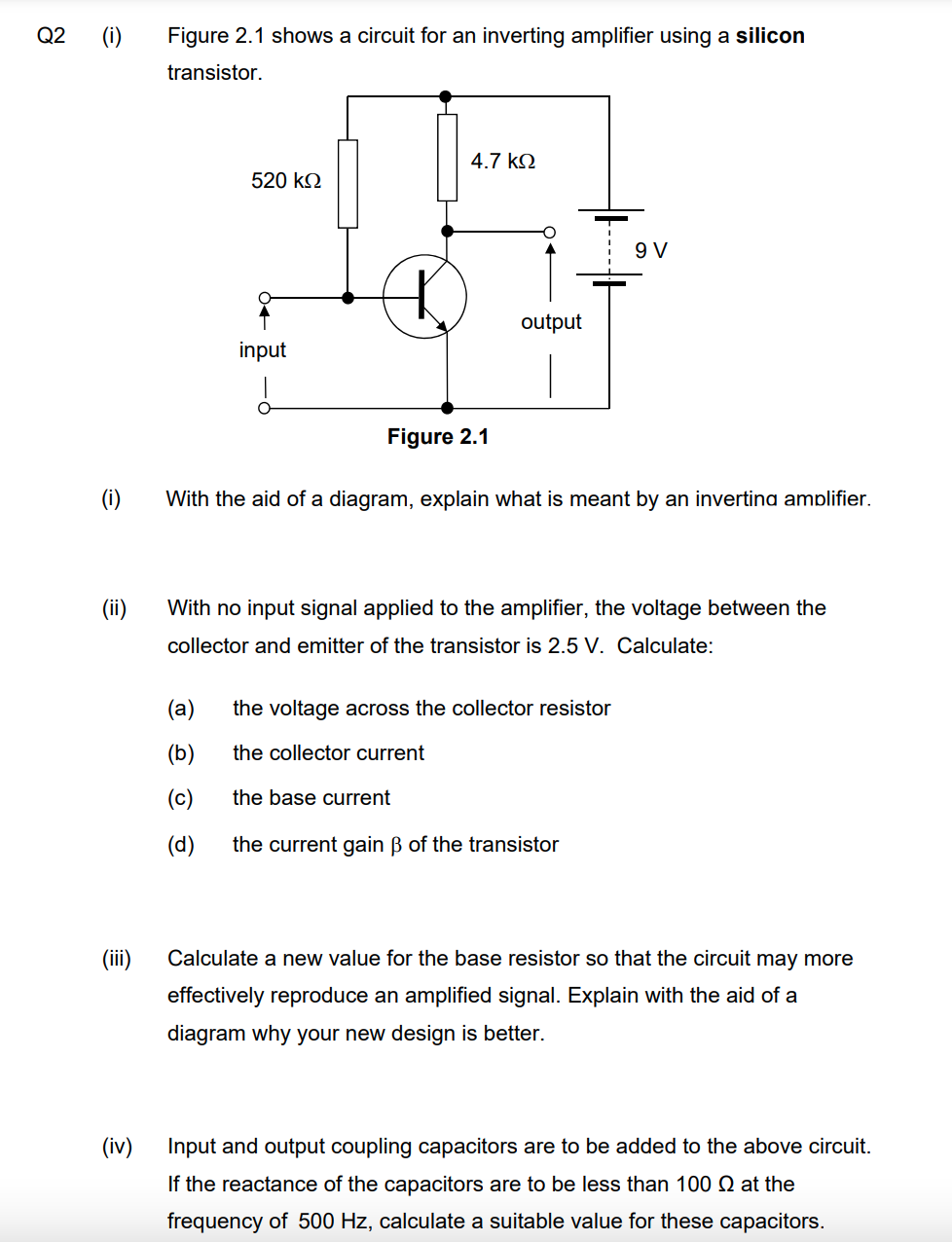(i) With the aid of a diagram, explain what is meant by an invertina amplifier. (ii) With no input signal applied to the amplifier, the voltage between the collector and emitter of the transistor is 2.5 V. Calculate: (a) the voltage across the collector resistor (b) the collector current (c) the base current (d) the current gain B of the transistor
(i) With the aid of a diagram, explain what is meant by an invertina amplifier. (ii) With no input signal applied to the amplifier, the voltage between the collector and emitter of the transistor is 2.5 V. Calculate: (a) the voltage across the collector resistor (b) the collector current (c) the base current (d) the current gain B of the transistor
Introductory Circuit Analysis (13th Edition)
13th Edition
ISBN:9780133923605
Author:Robert L. Boylestad
Publisher:Robert L. Boylestad
Chapter1: Introduction
Section: Chapter Questions
Problem 1P: Visit your local library (at school or home) and describe the extent to which it provides literature...
Related questions
Question
hi, can you help me with all parts of this question.
thank you

Transcribed Image Text:Q2
(i)
Figure 2.1 shows a circuit for an inverting amplifier using a silicon
transistor.
4.7 kQ
520 k2
9 V
output
input
Figure 2.1
(i)
With the aid of a diagram, explain what is meant by an invertina amplifier.
With no input signal applied to the amplifier, the voltage between the
collector and emitter of the transistor is 2.5 V. Calculate:
(a)
the voltage across the collector resistor
(b)
the collector current
(c)
the base current
(d)
the current gain B of the transistor
(ii)
Calculate a new value for the base resistor so that the circuit may more
effectively reproduce an amplified signal. Explain with the aid of a
diagram why your new design is better.
(iv)
Input and output coupling capacitors are to be added to the above circuit.
If the reactance of the capacitors are to be less than 100 Q at the
frequency of 500 Hz, calculate a suitable value for these capacitors.
Expert Solution
This question has been solved!
Explore an expertly crafted, step-by-step solution for a thorough understanding of key concepts.
Step by step
Solved in 3 steps with 7 images

Knowledge Booster
Learn more about
Need a deep-dive on the concept behind this application? Look no further. Learn more about this topic, electrical-engineering and related others by exploring similar questions and additional content below.Recommended textbooks for you

Introductory Circuit Analysis (13th Edition)
Electrical Engineering
ISBN:
9780133923605
Author:
Robert L. Boylestad
Publisher:
PEARSON

Delmar's Standard Textbook Of Electricity
Electrical Engineering
ISBN:
9781337900348
Author:
Stephen L. Herman
Publisher:
Cengage Learning

Programmable Logic Controllers
Electrical Engineering
ISBN:
9780073373843
Author:
Frank D. Petruzella
Publisher:
McGraw-Hill Education

Introductory Circuit Analysis (13th Edition)
Electrical Engineering
ISBN:
9780133923605
Author:
Robert L. Boylestad
Publisher:
PEARSON

Delmar's Standard Textbook Of Electricity
Electrical Engineering
ISBN:
9781337900348
Author:
Stephen L. Herman
Publisher:
Cengage Learning

Programmable Logic Controllers
Electrical Engineering
ISBN:
9780073373843
Author:
Frank D. Petruzella
Publisher:
McGraw-Hill Education

Fundamentals of Electric Circuits
Electrical Engineering
ISBN:
9780078028229
Author:
Charles K Alexander, Matthew Sadiku
Publisher:
McGraw-Hill Education

Electric Circuits. (11th Edition)
Electrical Engineering
ISBN:
9780134746968
Author:
James W. Nilsson, Susan Riedel
Publisher:
PEARSON

Engineering Electromagnetics
Electrical Engineering
ISBN:
9780078028151
Author:
Hayt, William H. (william Hart), Jr, BUCK, John A.
Publisher:
Mcgraw-hill Education,